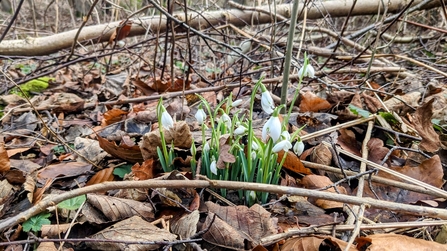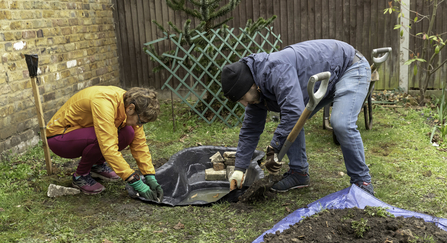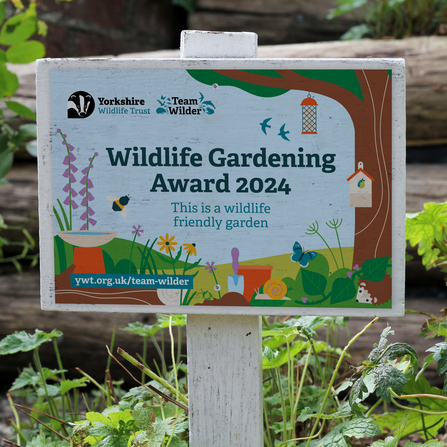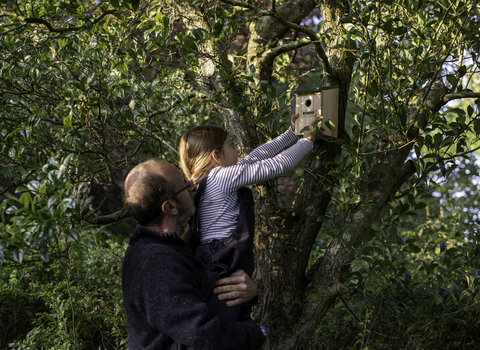We’ve had enough of the laden and heavy grey skies and are eager for the change and opportunities the lengthening days and first signs of spring bring. Snowdrops are pushing their delicate bell-like heads through the frozen earth, along with the jewel-like colours of early daffodils, crocuses and cyclamen, bringing with them promises of sweet-smelling, blue-skied spring.
The coming of spring
Crocus - Zsuzsanna Bird

Snowdrops at Brockadale nature reserve (c) Thom Day
Keeping sheltered
Your garden is a home for wildlife and shelter is absolutely vital – whether it’s from winter storms or summer sun. Providing safe hidey holes can be very straightforward indeed – even if you don’t have much space – and there are a lot of natural and attractive options.
Often the best course of action can be to do nothing! Something as simple as leaving a pile of stones, deadwood or logs undisturbed in a quiet corner can provide vital habitat for insects, as well as a convenient buffet for frog, birds, and hedgehogs. If you’d like to make it more sculptural, you could consider making a small drystone wall or wood pile. Similarly, bugs and insects will also hibernate in dead stalks and among fallen leaves – so don’t clear these from your garden too much before the end of March, as tempting as it might be. Chose plants too that leave attractive seedheads and make these a feature of your garden.
Plenty of hedges or bushes provide important shelter and protection for wildlife, particularly nesting birds and hibernating insects, provide natural windbreaks, areas of shade and food sources – and allow your local wildlife to move around. Native plants like hawthorn, field maple, blackthorn, dogwood, wild rose, hornbeam and holly are our top choices.
If you have a slightly bigger garden and are happy with a wilder look, why not make room for a tangle? A tangle is just a wild corner where brambles, nettles, thistles and dock have been left to thrive, providing shelter for a range of insects and small mammals, breeding space for creatures like butterflies and a food source too.
A ‘tangle’ (a wild corner where brambles and nettles have been left to thrive) (c) Jo R
Home sweet home
Show a love for birds from 14th February every year! National Nestbox Week encourages gardeners everywhere, no matter the size of their garden, to provide a safe space for visiting bird friends. Bird boxes are quick, easy and cheap to build, and incredibly rewarding; you will find yourself watching for potential homeowners very quickly, and prospecting visitors will arrive even faster if you already provide bird food. Once you have residents, the activity and dramas leading up to fledglings hopefully in June will have you gripped.
Swifts won’t arrive until early May so there’s also time to install a swift box. Swifts are sadly declining, with estimates that almost 60% have disappeared over the last 25 years. Providing a stable home will help these incredible, acrobatic sky arcs, and help them move into areas that have limited roosting space. Swifts are insect-eaters and will make a quick meal from other small winged things on summer evenings.
This time of year is also perfect to install a pond. If you have the space to put a full-sized pond into your garden, the benefits can be limitless – as well as providing a fantastic habitat for lots of amphibian species and insects, ponds are also vital sources of drinking water for wildlife year-round. However, with less space, bucket or container ponds are an equally viable prospect – they require less work than a traditional pond whilst attracting the same variety of exciting garden wildlife. Just make sure you keep it topped up! Bog gardens are good similar alternatives for families with small children, as they don’t involve deep water.

Keep a record
Start to count the birds, note the insects and record the frogs with the dates and numbers and keep a record throughout the year. Stay in tune with what’s there and when it appears to help you plan future activity and plant choices – you might be surprised with just how many different species are making themselves at home in the shrubs, log piles and pond. It’s not important to know the names of everything, but there’s lots of online resources on our website to help you.
As a final reward for your efforts, Yorkshire Wildlife Trust launched a Wildlife Gardening Award to inspire people to do more for wildlife in their gardens. The award recognises the valuable contribution that gardeners are already making, and encourages keen wildlife gardeners across Yorkshire to share what they are doing and the positive impact they are having.
Over the past year the Trust has received a wealth of wonderful applications spanning from care homes to community wild streets to allotments, and gardens to suit every size. In fact, to date the Trust has awarded nearly 450 gardens – and we’re sure there are many, many more wildlife-friendly gardens out there.

Yorkshire Wildlife Trust's Wildlife Gardening Award
To apply for a wildlife gardening award, visit our website and fill in the details.
Don’t forget to share pictures of your wild garden to inspire others!

Help wildlife at home
You’ll find more advice and instructions for creating bird boxes, bug hotels and making your outdoor space more friendly for wildlife on our action for wildlife page.
